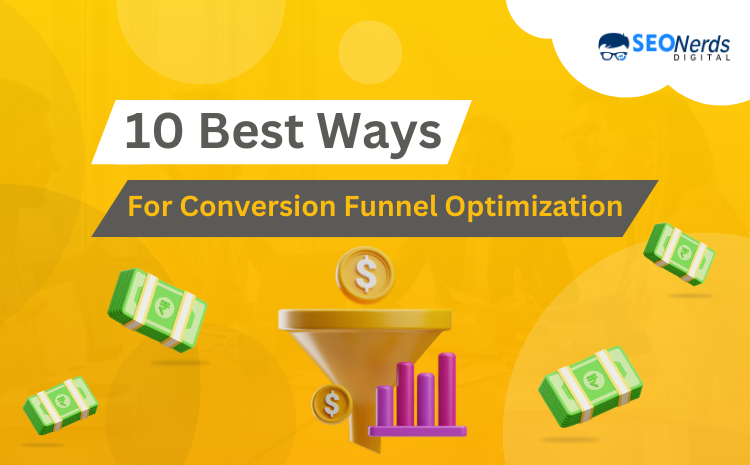10 Best Ways For Conversion Funnel Optimization

10 Tips For Conversion Funnel Optimization
Converting leads into satisfied customers is the ultimate goal for any sales and marketing team. This journey involves multiple steps, known as funnel stages. Your sales funnel outlines the process of making your audience aware of your product or service and persuading them to buy.
Effective conversion funnel optimization is key to guiding users seamlessly through these stages and enhancing your sales. In this article, we’ll dig deeper into how to optimize your conversion funnel and increase sales, regardless of your funnel’s structure. You will find practical tips to implement and learn how to analyze and measure your results effectively. Get ready to discover the best strategies for successful conversion funnel optimization.
Conversion Funnel Optimization – Overview

A conversion funnel maps the journey from a website visitor to a completed sale. It provides insights into how many individuals enter the funnel, where they drop off at various stages, and the percentage that ultimately makes a purchase. This process helps businesses understand their sales dynamics and identify areas for improvement.
In eCommerce, the conversion funnel is more intricate than traditional sales funnels. It typically comprises several stages, each representing a step in the customer’s journey from awareness to purchase. Visitors to your site are first introduced to your brand, some express interest and become leads, and the most promising leads eventually convert into paying customers.
Effective conversion funnel optimization focuses on improving each stage of this journey to boost the conversion rate. This involves using analytics tools, such as Google Analytics, to track user interactions with your website. By analyzing data on how users navigate through your funnel, you can identify drop-off points, refine your strategies, and enhance user experience.
The ultimate goal is to increase the number of visitors who progress through the funnel and become loyal customers. Ensuring that visitors are consistently aware of your brand and engaged throughout their journey is crucial for success. By optimizing the conversion funnel, businesses can improve their sales performance and achieve better results.
Importance of Conversion Funnel Optimization

At the core of Conversion funnel optimization is the drive to achieve higher conversion rates. By refining the customer journey, you can significantly boost the chances of transforming visitors into repeat customers. Here’s how optimizing your conversion funnel can benefit your business:
- Increased conversions: Enhancing the user journey makes it more user-friendly and persuasive, increasing the likelihood of turning website visitors into customers.
- Higher revenue: Improved ROI translate directly into increased revenue. There’s a strong connection between effective funnel optimization and tangible financial gains.
- Increased ROI (return on investment): By optimizing the funnel, you can maximize the value derived from your marketing and sales efforts, improving overall ROI.
- Improved customer satisfaction: When customers find your website or service easy and enjoyable to use, their satisfaction rises. This positive experience increases their chances of returning.
- Data-driven decision-making: Analytics provide valuable insights into user behavior and performance indicators. By analyzing and optimizing the funnel, businesses can make informed decisions about budgets and resources, effectively addressing funnel needs.
10 Ways To Optimize Your Conversion Funnel

Here are the top 10 strategies to enhance your conversion funnel optimization. These methods are designed to improve each funnel stage and help you maximize conversions for a good conversion funnel.
1. Define and Categorize Your Target Audience
Effective conversion funnel optimization starts with clearly defining your target audience. Identify the specific demographics of your target customers. Consider factors such as age, gender, occupation, interests, and social media presence. Understanding these aspects helps you gaining trust of the potential customers and tailor your approach to their needs.
By analyzing these details, you can optimize your funnel at key touchpoints throughout the sales process. This ensures that each stage of the funnel is aligned with your audience’s preferences. When the stages aren’t properly addressed, you risk losing valuable leads. Therefore, focusing on these elements can significantly boost your rate of converting customer engagement into successful sales
2. Tailoring Content for Every Stage of the Conversion Funnel
Each stage of the conversion funnel reflects a unique mindset and set of needs for your qualified leads. Tailoring your content to match these needs helps you deliver the right message at the right time, thereby improving your ROI.
Awareness-stage content: At this stage, target audience are seeking information. Your content should be educational and address their pain points. Create blog posts, infographics, and videos that introduce your industry, product or service.
Consideration-stage content: As prospects evaluate their options, provide content that highlights your product’s unique selling points. Share case studies, product demonstrations, and customer testimonials. This approach helps in guiding prospects through the conversion path.
Conversion-stage content: This stage involves making the final push. Offer promotional deals, limited-time discounts, and clear CTAs to encourage prospective customers to take the next step and complete their purchase.
Loyalty-stage content: After a purchase, express gratitude with personalized thank-you emails. Follow up with additional resources, tips, or exclusive offers to reinforce a positive post-purchase experience. This not only positions your brand as a valuable resource but also helps to reward customers’ loyalty with special offers, discounts, or membership in a loyalty program.
By aligning your content with each funnel stage, you efficiently use this information to guide prospects and improve your conversion rates.
Related – 10 Tips for Creating a Successful Business Blog
3. Capturing Leads With Lead Magnet
Lead magnets are incentives offered to potential customers in exchange for their contact details, usually their email addresses. Best examples include:
- Ebooks and whitepapers: In-depth resources that cover topics of interest to your target customers.
- Webinars and workshops: Live or recorded sessions that provide valuable insights, training, or demonstrations.
- Free trials and demos: Opportunities for prospects to experience your product or service firsthand.
- Checklists and templates: Practical tools that help your audience solve specific challenges.
- Exclusive offers and discounts: Special promotions available to those who subscribe or share their contact information.
Incorporate these lead magnets into relevant articles, email marketing campaigns, social media posts, and other marketing strategies. This strategy helps foster engagement and capture leads throughout different stages of a sales funnel. By leveraging these tactics, you can optimize your marketing game and enhance your conversion funnel optimization.
Did you know?
73% of B2B marketers say that webinars are one of the top lead generation tactics because they provide real-time interaction and valuable insights.
4. Enhance Your Landing Pages for Optimal Conversion
A landing page is crucial for any conversion funnel optimization strategy. When prospective clients arrive on your site through SEO tools, this page is often their first impression.
To make a strong impact, ensure the page clearly showcases your products and services in a visually engaging manner. Use Google Analytics to track performance and make data-driven improvements.
Facilitate the path to a sale by incorporating clear, compelling call-to-action buttons or providing easy-to-find contact information. This approach helps guide visitors through the buyer’s journey and boosts your website’s rate of conversion.
By tailoring this page to address different stages of the customer experience, you enhance the overall effectiveness of your optimization guide and increase the likelihood of conversions.
Also Check – What is Data-Driven SEO – Top Strategies For Success in 2024
5. Maximize Engagement with Expert Content Creation
Achieving success in sales requires more than just a strategy; it needs high-quality content. This is crucial for both top and middle-of-funnel marketing. With a solid grasp of your conversion funnel optimization and target customers, you can craft content that truly engages and leads customers to the final sale.
Expert content creators can design specialized materials that address the core customer needs your product or service resolves. By utilizing relevant media, you can effectively connect with your audience and nurture their interest. This approach helps to keep potential buyers engaged and reduces the chances of people leaving the funnel prematurely.
Incorporating well-crafted content into your marketing plan is a strategic way to find solutions that cater to specific pain points. This can enhance the overall effectiveness of your sales process, making it easier for prospects to take the next step, like adding an item to their cart.
Did You Know?
Content marketing generates over three times as many leads as outbound marketing and costs 62% less. (Source: Demand Metric)
6. Boost Conversions with a Strong Social Media Strategy
Maintaining an active social presence is key for conversion funnel optimization. Social media platforms offer a valuable opportunity to engage with your audience throughout the funnel. By creating and sharing posts on social media that resonate with your target market, you can guide users through specific stages of their buying journey.
For ecommerce businesses, this means crafting content that prompts users to take the desired action, whether it’s clicking through to a product page or signing up for a newsletter. Leveraging social media for sales and marketing efforts can help you reach potential clients at various points in their journey, driving conversions and boosting overall performance.
7. Create Compelling Calls to Action for Sales Funnel Success
A strong action prompt is crucial for enhancing your sales funnel optimization. Your funnel should clearly demonstrate how your product or service addresses a problem. However, without a compelling action prompt, turning this information into a sale becomes challenging.
A well-crafted action prompt guides your customers on what to do next, converting interest into action. Whether it’s signing up for a newsletter, your action prompt needs to create a sense of urgency. To be effective, ensure your action prompt is clear and direct. This approach helps drive more sales and enhances your overall conversion funnel optimization.
Statistics
A study by Unbounce found that using a button with a contrasting color for your CTA can improve click-through rates by 20% compared to using similar colors.
8. A/B Testing for Your Marketing Efforts Optimization
A/B testing is a powerful tool for enhancing your marketing efforts. This method involves comparing two versions of content to see which performs better. It’s often used for website design, revealing which layout or landing page appeals most to potential clients.
However, A/B testing can also be applied to other advertising content. By using this technique, you can refine your strategies and improve the customer journey. It provides valuable insights that help you understand what works best for your audience.
From detailed buyer personas to observing where users are dropping off, A/B testing offers insights into how to enhance customer satisfaction. Implementing these findings across multiple channels can significantly boost your conversion funnel optimization and lead to better results in your marketing campaign.
9. Leverage Social Proof to Enhance Trust and Boost Conversions
In today’s competitive marketplace, the opinions and experiences of others can significantly influence potential customers. Positive reviews, endorsements, and testimonials act as powerful guides in the decision-making process. Social proof helps in building trust and confidence, encouraging users to make a purchase.
To effectively leverage social proof, display it prominently across your marketing channels. Here are key examples:
- Customer reviews: Showcase positive testimonials from satisfied customers as authentic endorsements of your products or services.
- Case studies: Provide detailed accounts of successful client collaborations to highlight your brand’s effectiveness, especially in B2B or complex scenarios.
- User-generated content: Encourage customers to share their experiences through photos, videos, or posts, offering a genuine look at your brand.
- Influencer endorsements: Partner with industry influencers to boost your brand’s credibility. Their endorsements can persuade their followers to take action.
Utilizing these forms of social proof can help reduce abandonment rates and guide potential customers towards the action you want, enhancing your overall conversion funnel optimization.
Pro Tip
Showcase Real-Time Engagement: Feature recent user-generated content, like social media posts or photos, to highlight active customer involvement and satisfaction.
10. Measuring and Analyzing Performance
Measuring and analyzing performance is an ongoing process of refinement. Use data-driven insights to enhance your conversion funnel optimization efforts. Follow these steps to guide your strategy:
- Identify the path users take on your site using features like Users Flow.
- Map the customer journey with tools like the Funnels feature.
- Identify metrics that align with your conversion goals at each funnel stage, such as website traffic, click-through rates, and customer acquisition costs.
- Assess rates of conversion at various stages of the funnel. Find areas with significant drop-offs and investigate contributing factors.
- Use heatmaps and session recordings to observe how users interact with your site.
- Create experiments to test and improve specific areas within your funnel, using insights from heatmaps and session recordings.
By focusing on these elements, you can effectively optimize your marketing to meet the needs and interests of various customer segments. This systematic approach help marketers understand what actions you want them to take and refine your conversion process accordingly.
Conclusion

Sales funnel optimization is crucial for turning interest into actual sales and boosting overall business success. By focusing on each stage of the customer journey—from initial awareness to final purchase—marketers can better address consumer needs and increase conversions.
Effective strategies include segmenting audiences, capturing high-quality leads, optimizing landing pages, and conducting A/B tests. These actions help ensure that each interaction with potential customers is impactful and guides them effectively through their path to purchase.
Continuous measurement and analysis are essential for refining these strategies and adapting to shifting consumer preferences. By implementing these practices, marketers can significantly improve conversion funnel optimization, which could include conversion success rate, better understanding consumer preferences, and enhancing the overall path to purchase.
FAQs
Q1: What is Conversion Funnel Optimization?
Ans. Conversion funnel optimization is the ongoing process of refining each stage of a sales or marketing funnel to boost the rate at which users complete desired actions. It involves analyzing how potential customers move from awareness to purchase, identifying friction points, and making strategic adjustments to enhance conversion rates and streamline the customer journey.
Q2: How can funnel conversion rates be improved?
Ans. To improve your funnel conversion efficiency start with a cultural commitment to optimization. Understand your funnel and identify friction points. Streamline the user experience and use A/B testing to find effective methods. Personalize interactions, build trust, and monitor metrics continuously to track and refine performance.
Q3: What does 3-funnel strategy involve?
Ans. The 3-funnel strategy maps out the customer journey in three stages: awareness (initial brand introduction), nurturing (building relationships with leads), and conversion (turning leads into customers). This structured approach helps manage each stage effectively, guiding prospects from interest to purchase.
Q4: What are the 4 marketing funnel stages?
Ans. The four stages are - awareness (attracting customers), consideration (providing information), conversion (driving purchases), and loyalty (retaining customers). Each stage aims to move customers from initial contact to ongoing engagement.
Q5: How can a target audience be defined?
Ans. Identify your target audience by analyzing your current customers' demographics, interests, and behaviors. Engage them through social media or surveys to gather insights. This helps create detailed buyer personas and tailor your marketing strategies to meet their specific needs.











Write a Comment